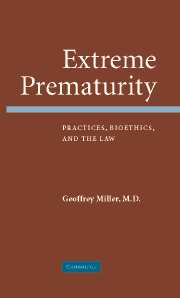Book contents
- Frontmatter
- Contents
- Part 1 THE EXTREMELY PRETERM INFANT: EPIDEMIOLOGY, PERCEPTIONS, AND PRACTICES
- 1 Introduction
- 2 Historical Aspects
- 3 Survival
- 4 Influence of Obstetric Management
- 5 Effect of Resuscitation in the Delivery Room
- 6 National Comparisons
- 7 Prediction of Outcome
- 8 Limit of Viability
- 9 Morbidity
- 10 School Age Outcome
- 11 Adolescence
- 12 Perceptions and Practices
- 13 Resource Expenditure
- Part 2 BIOETHICS
- Part 3 REPORTS, OFFICIAL OPINIONS, AND GUIDELINES
- Part 4 THE LAW
- Part 5 EPILOGUE: TRUTH, TRUST, AND BOUNDARIES
- References
- Index
5 - Effect of Resuscitation in the Delivery Room
Published online by Cambridge University Press: 23 September 2009
- Frontmatter
- Contents
- Part 1 THE EXTREMELY PRETERM INFANT: EPIDEMIOLOGY, PERCEPTIONS, AND PRACTICES
- 1 Introduction
- 2 Historical Aspects
- 3 Survival
- 4 Influence of Obstetric Management
- 5 Effect of Resuscitation in the Delivery Room
- 6 National Comparisons
- 7 Prediction of Outcome
- 8 Limit of Viability
- 9 Morbidity
- 10 School Age Outcome
- 11 Adolescence
- 12 Perceptions and Practices
- 13 Resource Expenditure
- Part 2 BIOETHICS
- Part 3 REPORTS, OFFICIAL OPINIONS, AND GUIDELINES
- Part 4 THE LAW
- Part 5 EPILOGUE: TRUTH, TRUST, AND BOUNDARIES
- References
- Index
Summary
In 1996, Rennie wrote that outcome after full cardiopulmonary resuscitation (CPR) following delivery of a very preterm infant was “appalling.”(48) Her justifications for this conclusion were reports published in the early 1990s. In one, from Manchester, England, three of five babies born less than 28 weeks' gestation, who received full CPR, including adrenaline, died and the survivors were handicapped.(49) In a report from Oklahoma, there were no survivors of very low birth weight (VLBW) infants who required more than one resuscitative attempt.(50) In similar circumstances there were only two normal survivors, during the years 1989–1993, reported in a study from Cambridge, England, and all six infants given full CPR in Ottawa, Canada, with birth weights less than 750g, during 1989–1992, died.(51) In sharp contrast to these reports are later ones that suggest that condition at birth of an EPTI may not be a good indicator of viability or later outcome.(52) Jankov, Asztalos, and Skidmore evaluated whether vigorous resuscitation of ELBW infants at birth improved survival or increased the chances of major neurodevelopmental disability. They reported the outcome of a group of infants born weighing 750g or less who received CPR (positive pressure ventilation, cardiac compression, +/− adrenaline) in the delivery room. About 57% survived, and 88% were free of major neurodevelopmental disability at follow-up.(53) Similar findings have been published by several other authors(54–56) and it does appear that CPR in the delivery room for the EPTI does not necessarily lead to a large decrease in survival or an increase in major neurologic sequelae compared to those who survived following only intubation and positive pressure ventilation.
- Type
- Chapter
- Information
- Extreme PrematurityPractices, Bioethics and the Law, pp. 18 - 19Publisher: Cambridge University PressPrint publication year: 2006



